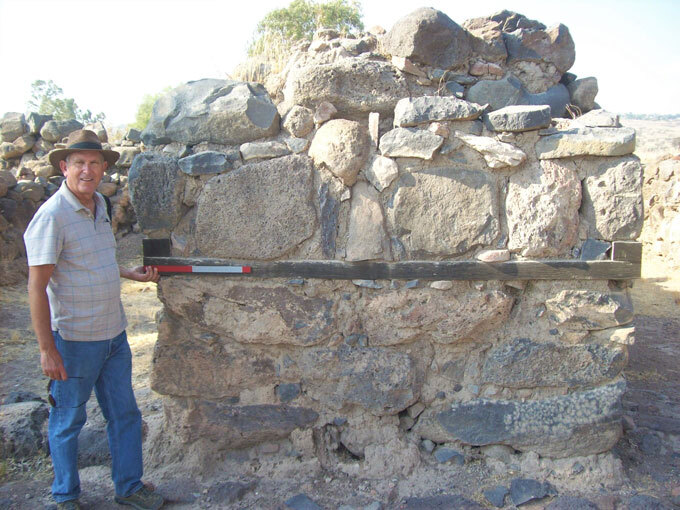Early versions of the Bible describe Goliath — an ancient Philistine warrior best known as the loser of a fight with the future King David — as a giant whose height in ancient terms reached four cubits and a span. But don’t take that measurement literally, new research suggests.
Archaeological findings at biblical-era sites including Goliath’s home city, a prominent Philistine settlement called Gath, indicate that those ancient measurements work out to 2.38 meters, or 7 feet, 10 inches. That’s equal to the width of walls forming a gateway into Gath that were unearthed in 2019, according to archaeologist Jeffrey Chadwick of Brigham Young University in Provo, Utah.
Rather than standing taller than any NBA player ever, Goliath was probably described metaphorically by an Old Testament writer as a warrior who matched the size and strength of Gath’s defensive barrier, Chadwick said November 19 at the virtual annual meeting of the American Schools of Oriental Research.
People known as Canaanites first occupied Gath in the early Bronze Age, roughly 4,700 to 4,500 years ago. The city was rebuilt more than a millennium later by the Philistines, known from the Old Testament as enemies of the Israelites (SN: 11/22/16). Gath reached its peak during the Iron Age around 3,000 years ago, the time of biblical references to Goliath. Scholars continue to debate whether David and Goliath were real people who met in battle around that time.
The remains of Gath are found at a site called Tell es-Safi in Israel. A team led by archaeologist Aren Maeir of Bar-Ilan University in Ramat-Gan, Israel — who Chadwick collaborated with to excavate the Gath gateway — has investigated Tell es-Safi since 1996. Other discoveries at Gath include a pottery fragment inscribed with two names possibly related to the name Goliath. Evidence of Gath’s destruction about 2,850 years ago by an invading army has also been recovered.

Archaeologists have long known that in ancient Egypt a cubit corresponded to 52.5 centimeters and assumed that the same measure was used at Gath and elsewhere in and around ancient Israel. But careful evaluations of many excavated structures over the last several years have revealed that standard measures differed slightly between the two regions, Chadwick said.
Buildings at Gath and several dozen other cities from ancient Israel and nearby kingdoms of Judah and Philistia, excavated by other teams, were constructed based on three primary measurements, Chadwick has found. Those include a 54-centimeter cubit (versus the 52.5-centimeter Egyptian cubit), a 38-centimeter short cubit and a 22-centimeter span that corresponds to the distance across an adult’s outstretched hand.
Dimensions of masonry at these sites display various combinations of the three measurements, Chadwick said. At a settlement called et-Tell in northern Israel, for instance, two pillars at the front of the city gate are each 2.7 meters wide, or five 54-centimeter cubits. Each of four inner pillars at the city gate measure 2.38 meters wide, or four 54-centimeter cubits and a 22-centimeter span. Excavators of et-Tell regard it as the site of a biblical city called Bethsaida.
Chadwick’s 2019 excavations found one of presumably several gateways that allowed access to Gath through the city’s defensive walls. Like the inner pillars of et-Tell’s city gate, Gath’s gate walls measured 2.38 meters wide, or four cubits and a span, the same as Goliath’s biblical stature.
“The ancient writer used a real architectural metric from that time to describe Goliath’s height, likely to indicate that he was as big and strong as his city’s walls,” Chadwick said.
Although the research raises the possibility that Goliath’s recorded size referred to the width of a city wall, Chadwick “will need to do more research to move this beyond an intriguing idea,” says archaeologist and Old Testament scholar Gary Arbino of Gateway Seminary in Mill Valley, Calif. For one thing, Arbino suggests, it needs to be established that the measure applied to Goliath, four cubits and a span, was commonly used at the time as a phrase that figuratively meant “big and strong.”
"may" - Google News
November 23, 2020 at 06:00PM
https://ift.tt/2Hqr1MM
The biblical warrior Goliath may not have been so giant after all - Science News
"may" - Google News
https://ift.tt/3foH8qu
https://ift.tt/2zNW3tO
Bagikan Berita Ini
















0 Response to "The biblical warrior Goliath may not have been so giant after all - Science News"
Post a Comment